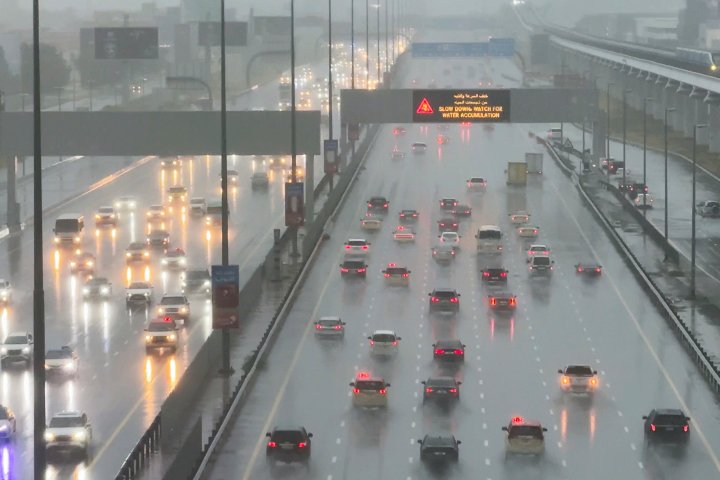

Workers on scaffolding repair a broken storefront, a produce market is bustling and girls in blue tunics walk home from school.
The so-called Islamic State is gone and Mosul is coming back to life.
“It’s beautiful,” said an Iraqi Christian who returned to Mosul after waiting out the ISIS years in Erbil, one of almost a million who fled the city.
Sitting in his roofless house, which was confiscated by ISIS fighters who torched it, he flicked a cigarette butt into a hole in the floor apparently left by a mortar round.
“I really feel secure,” he said.
But the damage is extensive.
READ MORE: Wives of ISIS fighters want to return home to Canada
Entire neighbourhoods of this northern Iraqi city were leveled, and body parts remain visible in the rubble on the bank of the Tigris River.
On a narrow street in the old city, a local teacher opened an unlocked metal door to what he said was an ISIS chemical weapons stash, still insecure more than a year after the end of fighting.
Ghazi Awaf said life under ISIS was hard. He lost two children in a missile strike, and piles of debris fill the rooms of his house. But he called living conditions today worse.
“We don’t have any shelter, we don’t have any jobs,” he said.
He singled out the role of the ISIS foreign fighters who came to Iraq to impose their brutal ideology. “There were Canadians and Americans, German, Russian. They entered with ISIS. They hurt us a lot,” he said.
WATCH: Canadian ISIS fighter captured in northern Syria speaks out

The United Nations marked the one-year anniversary of the defeat of ISIS in Mosul by noting the progress: the return of 870,000 people, the re-opening of schools and restoration of the electrical grid.
But it said more than two million Iraqis were still displaced, and those who had returned to Mosul and the other liberated regions faced “a multitude of challenges.”
Mohamed Ayd Hussein was among those who left a refugee camp and returned home after ISIS was driven from his town.
But he got back to find his house destroyed and water and electricity scarce.
So he returned to the camp. There’s a school for his kids. And the camp’s donors, who include the government of Canada, provide the basics of life.
Almost 5,000 still live at the Baharka Camp in northern Iraq. A camp manager said 400 refugee families had left, only to return because of the devastation and insecurity they encountered upon arriving in their home communities.
Khatr Khalif Rasheed said he got back to his farm and discovered an Iranian-backed militia called Asaib Ahl Haq had blown up the houses — a message to the town’s Arabs to stay away.
The destruction in Mosul is shocking.
Residents complained about the supply of water and electricity, and a weak local government. They said they feared ISIS sleeper cells but were most angry about a housing shortage they said had driven up rents, making them unaffordable to those struggling to get back to work.
“It’s better that there’s no bombing, no slaughtering,” said Mohamed, a 20-year-old who survived ISIS rule. “People are living but the hard thing right now is the destruction, salaries, money.”
READ MORE: In Mosul, Iraqi volunteers train to rehabilitate kids ‘brainwashed’ by Islamic State
Across the street from Mohamed’s family restaurant is the Al-Nuri mosque. It was here that ISIS leader Abu Bakr Al-Baghdadi declared the creation of an Islamic State in June 2014.
Before his speech, ISIS sealed the off the block and Al-Baghdadi arrived in a white Land Cruiser, he said. Mohamed heard him announce through the mosque loudspeaker that he was the leader of the Islamic State.
WATCH: Suspected chemical weapons lab in Mosul has yet to be cleaned up

Mosul thus became the Iraqi base of ISIS, to complement its Syrian capital in Raqqa. ISIS then began enforcing its version of Islamic law on the people, rallying around the slogan “remaining and expanding.”
A student, Mohamed said at first, ISIS fighters put on a good face, but after a few months they made the city a living hell with their absurd rules, public beheadings and cruel punishments.
WATCH: Illustrating Syria’s civil war and life under ISIS

Mohamed said he was taken away by ISIS at least five times. For not going to mosque. For wearing his beard too short and his pants too long. He said they tried to force him to join but eventually let him go.
The teacher said ISIS even militarized math, producing textbooks with problems like: one bullet plus two bullets equals three bullets. When he was caught smoking, he was taken to prison and flogged with a cable, he said.
The Battle of Mosul began in October 2016. The Iraqi Security Forces, Kurdish fighters and Shia militias, with U.S. support, corralled ISIS in the old city which was ravaged by fighting until Iraq’s prime minister declared victory on July 11, 2017.
“ISIL has left significant destruction in its wake,” the UN wrote in a report that said the terror group had deliberately damaged infrastructure and left the city “infested” with explosive devices.
Four years after Al-Baghdadi spoke from its pulpit, the Al-Nuri mosque is also in ruins, although whether it was blown up by ISIS itself or by anti-ISIS forces remains a matter of dispute.
The green dome is still standing, supported by sturdy columns that were built to last, but the red rugs are buried under a layer of rock and dust, and heaps of smashed concrete ring the grounds.
Above the spot where Baghdadi made his first public appearance and called on the world’s Muslims to bow to him, a rejection of his fanaticism is scrawled in black paint.
“F—k ISIS,” it reads.
Stewart.Bell@globalnews.ca














Comments